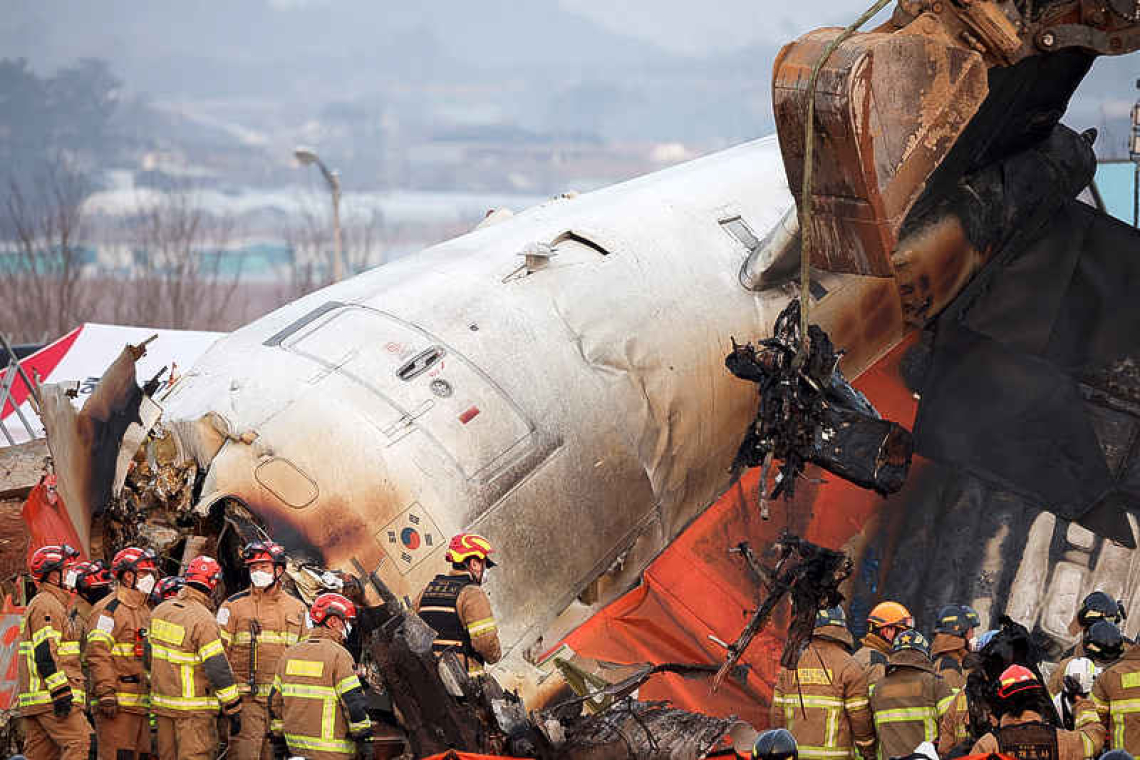MUAN COUNTY, South Korea--The deadliest air accident ever in South Korea killed 179 people on Sunday, when an airliner belly-landed and skidded off the end of the runway, erupting in a fireball as it slammed into a wall at Muan International Airport.
Jeju Air flight 7C2216, arriving from the Thai capital Bangkok with 175 passengers and six crew on board, was trying to land shortly after 9 a.m. at the airport in the south of the country, South Korea's transport ministry said.Two crew members survived and were being treated for injuries.
The deadliest air accident on South Korean soil was also the worst involving a South Korean airline in nearly three decades, the transport ministry said.The twin-engine Boeing 737-800 was seen in local media video skidding down the runway with no visible landing gear before crashing into navigation equipment and a wall in an explosion of flames and debris.
"Only the tail part retains a little bit of shape, and the rest of (the plane) looks almost impossible to recognise," Muan fire chief Lee Jung-hyun told a press briefing.
The two crew members, a man and a woman, were rescued from the tail section of the burning plane, Lee said. They were being treated at hospitals with medium to severe injuries, said the head of the local public health centre.
Investigators are examining bird strikes and weather conditions as possible factors, Lee said. Yonhap news agency cited airport authorities as saying such a strike may have caused the landing gear to malfunction.
The crash was the worst for any South Korean airline since a 1997 Korean Air crash in Guam that killed more than 200 people, transportation ministry data showed. The previous worst on South Korean soil was an Air China crash that killed 129 in 2002.
Experts said the bird strike report and the way the aircraft attempted to land raised more questions than answers. "At this point there are a lot more questions than we have answers. Why was the plane going so fast? Why were the flaps not open? Why was the landing gear not down?," said Gregory Alegi, an aviation expert and former teacher at Italy's air force academy.
Under global aviation rules, South Korea will lead a civil investigation into the crash and automatically involve the National Transportation Safety Board (NTSB) in the United States where the plane was designed and built.The NTSB said later it was leading a team of U.S. investigators to help South Korea's aviation authority. Boeing and the Federal Aviation Administration were also taking part.
Hours after the crash, family members gathered in the airport's arrival area, some crying and hugging as Red Cross volunteers handed out blankets.Many victims appeared to be residents of nearby areas returning from vacation, officials said.
Family members screamed and wept as a medic announced the names of victims identified by their fingerprints. One relative stood at a microphone to ask for more information from authorities. "My older brother died and I don’t know what’s going on," he said.
Mortuary vehicles lined up outside to take bodies away, and authorities said a temporary morgue had been established.A transport ministry official said the control tower had issued a bird strike warning and shortly after the pilots declared mayday and then attempted to land from the opposite direction the plane had come in.
A passenger texted a relative to say a bird was stuck in the wing, the News1 agency reported. The person's final message was, "Should I say my last words?"
Jeon Je-young, the 71-year-old father of one woman on board, played and replayed a video of the crash."When I saw the accident video, the plane seemed out of control," said Jeon.
"The pilots probably had no choice but to do it. My daughter, who is only in her mid-40s, ended up like this. This is unbelievable," he said. "She was almost home."
The Boeing model involved in the crash, a 737-800, is one of the world’s most flown airliners with a generally strong safety record. It was developed well before the MAX variant involved in a recent Boeing safety crisis.The aircraft was manufactured in 2009, the transport ministry said.







